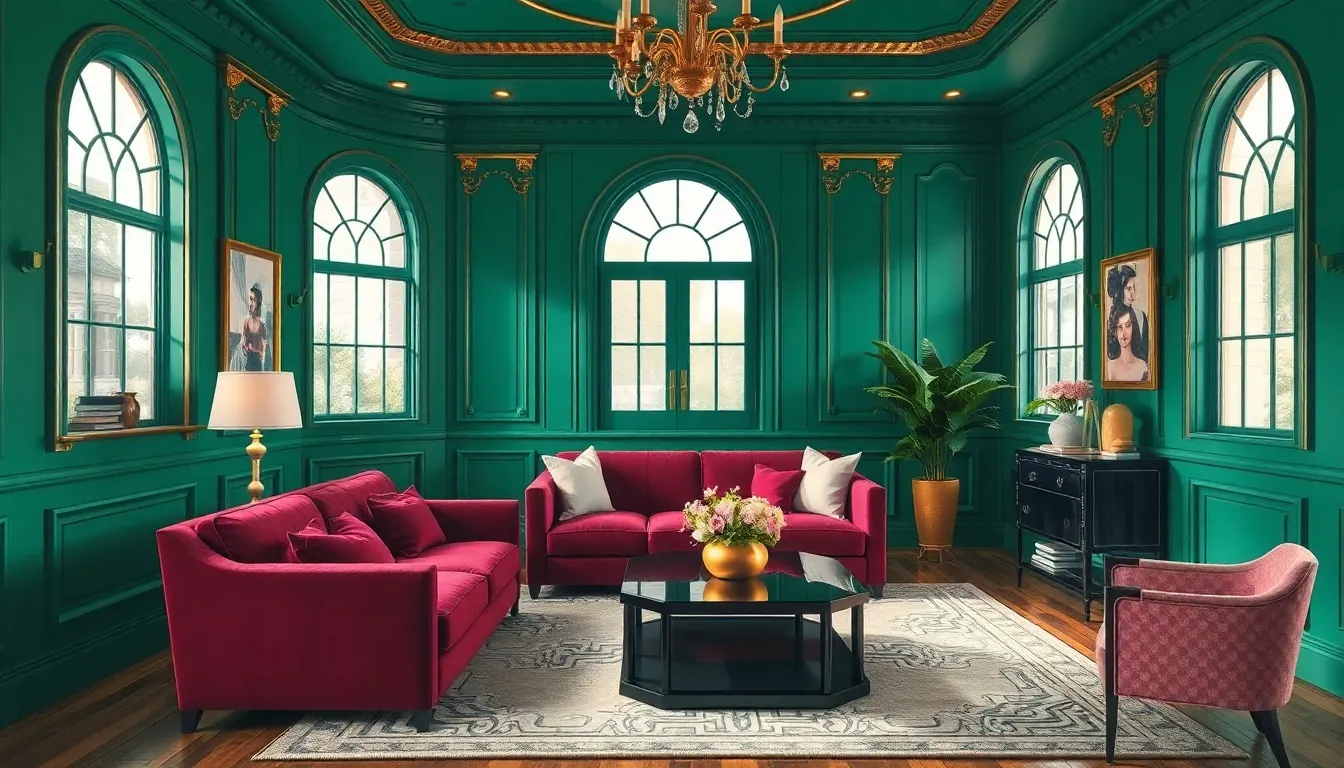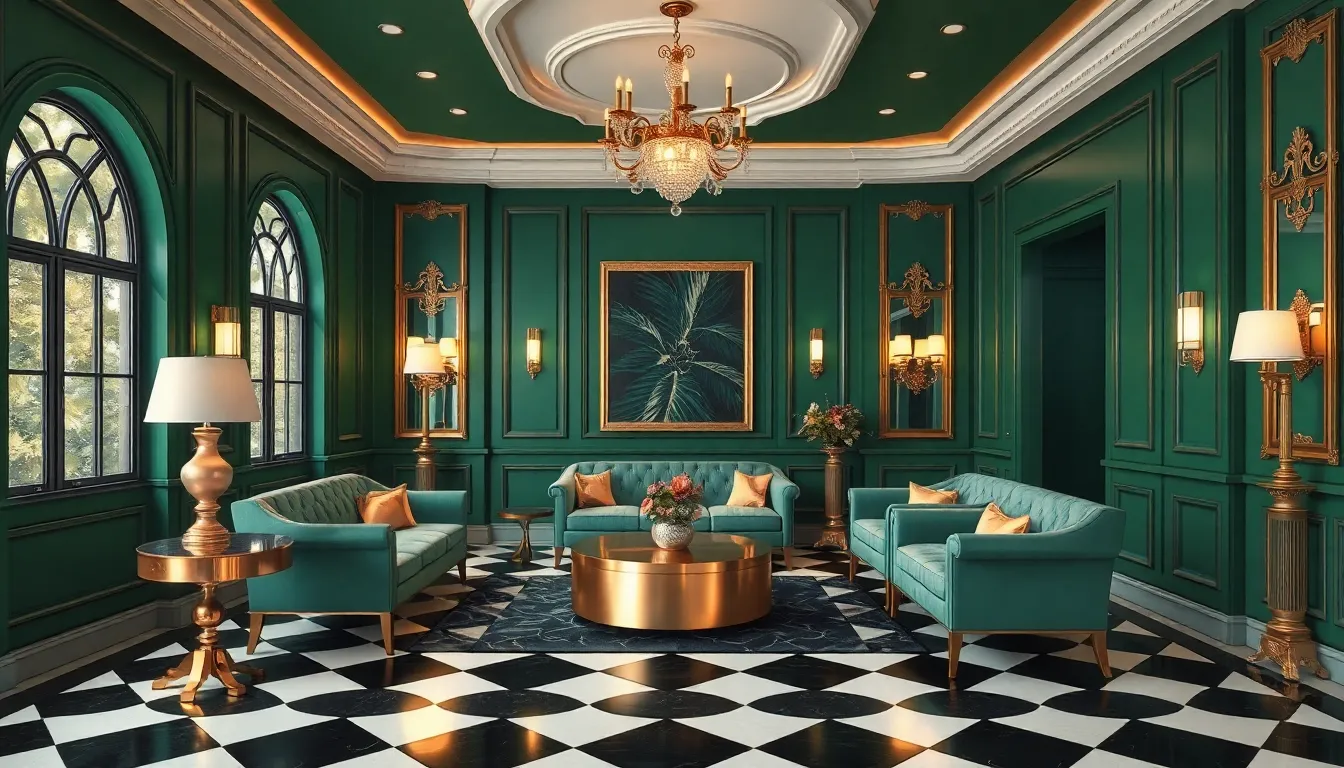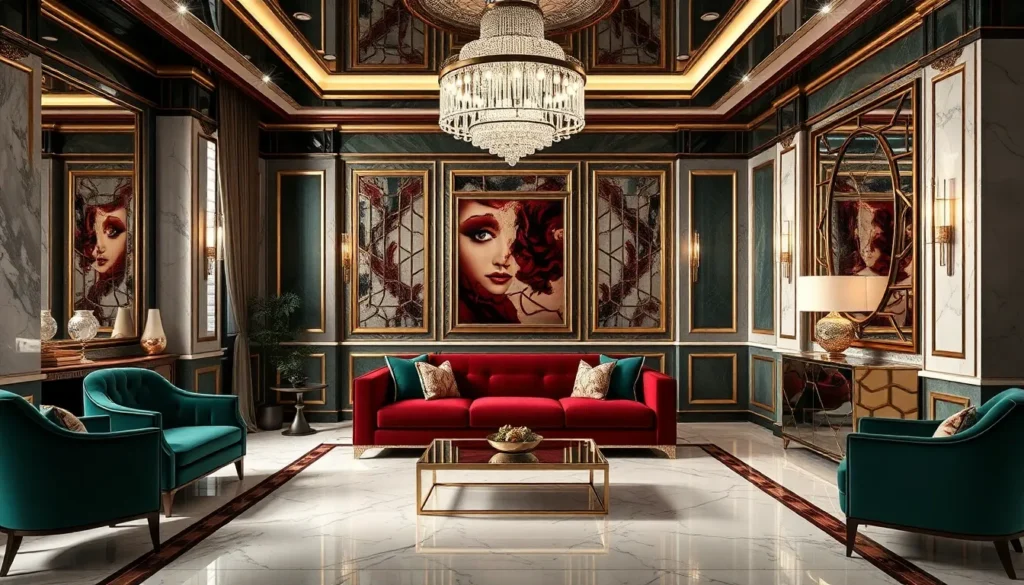Table of Contents
ToggleStep into the glamorous world of Art Deco interiors, where elegance meets exuberance in a delightful dance of style. This design movement, born in the roaring twenties, transformed mundane spaces into luxurious retreats. Think of it as the sophisticated cousin of modern design—one that knows how to throw a party and dress to impress.
Overview of Art Deco Interiors
Art Deco interiors reflect a unique blend of luxury and bold aesthetics, making spaces feel both sophisticated and inviting. Characterized by their distinct styles, these interiors exhibit a rich historical foundation.
Historical Context
Emerging in the 1920s, the Art Deco movement arose in response to the changing societal values after World War I. Influences from Cubism, Futurism, and the Bauhaus stream contributed to its development. Paris served as the epicenter for this artistic wave, shaping design trends globally. The 1925 Exposition Internationale des Arts Décoratifs showcased Art Deco’s opulence and intricate craftsmanship. This progressive style spread rapidly through architecture, fashion, and interior design, cementing its legacy.
Key Characteristics
Art Deco interiors feature geometric shapes and bold colors, communicating a sense of modern elegance. Lavish materials such as marble, chrome, and glass define this design style, emphasizing a luxurious aesthetic. Symmetry plays a vital role in layout, often creating harmonious focal points. Lighting fixtures exhibit elaborate designs, enhancing the enchanting atmosphere. Furniture appears streamlined, blending function with artful forms, reflecting the movement’s innovative spirit.
Color Palettes in Art Deco Interiors


Art Deco interiors showcase striking color palettes that enhance their luxurious appeal. Bold shades and rich tones define the aesthetic, creating spaces filled with character.
Popular Colors
Deep hues like emerald green, royal blue, and burgundy feature prominently in Art Deco design. Metallic colors, particularly gold and silver, add a touch of opulence. Crisp white provides contrast and highlights geometric shapes. Black serves as a staple, offering depth and sophistication. Soft pastels occasionally complement bolder shades, softening the overall look while maintaining an elegant ambiance.
Combinations and Contrasts
Contrasting colors play a crucial role in Art Deco interiors. Pairing rich greens with gold accents creates a luxurious feel. Blue and black combinations yield drama and visual interest. Warm red contrasts beautifully with cooler tones, adding vibrancy. Juxtaposing light and dark shades contributes to a dynamic atmosphere, enhancing architectural features and furniture. Varied color combinations enrich the Decoesque aesthetic, making each space a unique expression of style.
Furniture and Decor Styles
Art Deco interiors showcase distinctive furniture and decor styles that emphasize luxury and sophistication. These elements combine to create engaging spaces that reflect the era’s vibrant aesthetics.
Iconic Furniture Designs
Art Deco furniture features clean lines and bold geometric forms. Pieces often include luxurious materials like polished wood and chrome. Iconic designs include glamorous armchairs with curved backs and streamlined sofas that invite relaxation. The use of bold patterns and contrasting colors enhances visual interest. Noteworthy examples include the sleek, angular shapes of the famous Paul Frankl’s “Skyscraper” dresser. These furniture designs embody the elegance typical of the Art Deco movement.
Decorative Elements
Decorative elements play a crucial role in establishing the Art Deco ambiance. Elaborate lighting fixtures, such as geometric chandeliers and sconces, create a striking focal point. Mirrors with intricate frames reflect light, enhancing the space’s brilliance. Decorative accessories, like vases and sculptures, often feature motifs like sunbursts and zigzags, conveying movement and energy. Bold textiles—rich velvets and silks—add texture and warmth to elegant surroundings. These elements together contribute to an atmosphere of opulence that defines Art Deco interiors.
Lighting in Art Deco Interiors
Lighting holds a significant role in Art Deco interiors, enhancing elegance and creating visual impact. The style emphasizes bold, artistic fixtures that align with its luxurious aesthetic.
Types of Lighting Fixtures
Brilliant chandeliers serve as focal points, often crafted from glass or crystal. Sconces mounted on walls add dimension and style, frequently featuring geometric designs. Table lamps made with materials like chrome enhance the overall sophistication. Popular options include lamps with rich fabrics or intricate patterns. Pendant lights frequently integrate bold colors and shapes, complementing other elements of the decor. Echoing the grandeur of the era, these fixtures reflect light artfully while accentuating features of the room.
Creating Ambiance
Establishing ambiance relies on strategic lighting that highlights the dramatic aesthetics. Dimmers allow adjustments, enabling the control of brightness according to mood. Layered lighting adds depth; soft illumination often complements a striking chandelier. Warm light exudes a welcoming feel, while cooler tones introduce a more modern touch. Throwing light on architectural features emphasizes the geometric forms prevalent in Art Deco design. Overall, effective lighting transforms spaces, enhancing the luxurious experience inherent to Art Deco interiors.
Incorporating Art Deco in Modern Design
Incorporating Art Deco elements into modern design creates a striking contrast while maintaining sophistication. The blend of traditional Art Deco features with contemporary styles results in unique interiors that stand out.
Blending Styles
Combining Art Deco with minimalism produces elegant spaces that avoid clutter. Modern furnishings integrate geometric patterns and rich textures typical of Art Deco without overwhelming the eye. Luxurious fabrics like velvet and silk complement sleek surfaces found in contemporary design. Mixing vintage Art Deco pieces with modern accents enhances visual interest and ties the old with the new. Natural elements, such as wood and stone, work well alongside bold metallic finishes characteristic of Art Deco.
Tips for Implementation
Start by selecting a dominant color palette that reflects Art Deco’s boldness while incorporating modern neutrals. Choosing statement furniture pieces, like an Art Deco-inspired sofa, anchors the room. Use mirrors to accentuate light and create depth; they reflect the geometric shapes often seen in this style. Layering textiles adds warmth and richness, enhancing the overall ambiance. Consider lighting fixtures, such as sleek chandeliers or sconces, to illuminate spaces while echoing the elegance of Art Deco design.




